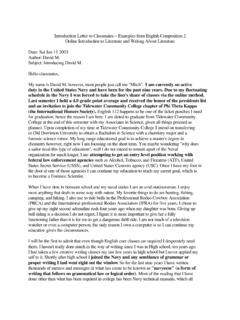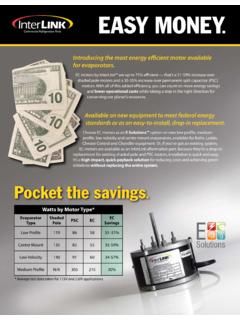Transcription of Teacher’s Guide to Introducing Debate in the …
1 Site: email: s GuidetoIntroducing Debatein the ClassroomSpeech and Debate UnionTeacher s Guide to Introducing Debate in the ClassroomSpeech and Debate Union Page 1 of 29 pagesINTRODUCTION TO Debate : Debate 1 Title: Introduction to Debate ..4 UNIT 2 Title: Expanding on the concept of Debate ..8 UNIT 3 Title:Affirmative case structure ..12 UNIT 4 Title: Overview of Negative strategy ..16 UNIT 5 Title:Overview of Debate ..20 UNIT 6 Title:Discussion in detail ..24 UNIT 7 Title:The great s Guide to Introducing Debate in the ClassroomNewfoundland and LabradorPage 2 of 29 pagesNewfoundland and LabradorINTRODUCTION TO Debate : OVERVIEWThe objective of this resource is to provide an introduction to Debate that willallow you to use Debate in the classroom . Debate in the classroom can be anend in itself, or it can be used as a way to facilitate research and discussion ofan issue in the curriculum.
2 Whether it is used for the latter purpose or not, therecipients will benefit from developing public speaking skills, critical thinkingskills, research skills and teamwork skills. It is possible to develop competency in Debate without speech training. Thereis no question, however, that a student's competence in Debate will developmore rapidly if accompanied by some training in public speaking. If you chooseto get right into Debate , this competence in public speaking will come with timeand practice. During the last 30 years there has been a growing interest among Canadianeducators in promoting Debate , particularly to provide a pedagogical structurefor the oral component of curricula . Although Debate is as old as Greekphilosophy, it is only during the last two decades that associations have existedin Canada for the purpose of encouraging involvement in Debate .
3 In Newfoundland and Labrador, two such associations are the NewfoundlandFederated League of Debaters (NFLD) and the Newfoundland and LabradorSpeech and Debate Union (SDU). Debate is often seen as more intimidating and more difficult than publicspeaking. To some extent, this perception is correct. Unlike public speaking,there is an expectation that the participant will react to and challengecontentions made by other speakers (opponents). This means that, althoughpreparation is essential, in many cases it is not possible to prepare should not be viewed as intimidating. What we are dealing with here is thechallenge of learning to be resourceful thinkers who can synthesize ideas andquickly articulate them. If you think about it, this is one of the most basic, butimportant, skills that educators can offer students.
4 Debate is based on simple,logical concepts and does not need to be conducted in a formal and rigid often involve two teams of two people speaking in a specific order; thisis just one type of Debate . The process is infinitely variable and whatever worksin your class is fine. Depending on the circumstances, the debates may work better if you useteams of 3 or 4 or more students. You will have to consider the maturity of yourstudents, the time available and the size of the and Debate UnionTeacher s Guide to Introducing Debate in the ClassroomSpeech and Debate Union Page 3 of 29 pagesGeneric Debate FormatThere are different types of Debate and it is important that you know what kindof Debate you will be participating in. There are some things, however, that alldebate formats have in common:1)There is a resolution of policy or value that provides the basicsubstance of the discussion.
5 The terms of this resolution will be definedby the first speaker of the )There are two teams representing those in favour of the resolution(Government or Affirmative) and those against (Opposition or Negative)3)The Government/Affirmative always has the burden to prove its )The Debate closes with final rebuttals on both sides which summarisetheir respective Debate Overview(Does not show breaks, cross-examination, and discussion.)1st Affirmative1st Negative2nd Affirmative2nd NegativeNeg RebuttalAff RebuttalIntroductionIntroductionIntroduc tionIntroductionNo new arguments can beintroduced .Explain why your team should winand the other team should loseRemind the judges of the judges why they shouldbelieve your arguments even afterthe other team's attackExplain why the judges should notlisten to the other teamReview critical necessary,attack definitionsClash with pointsmade by Negativeand rebuildAffirmative case(proof)Continueattack on Affirmative(proof)Explain why presentsystem is bad andneeds change (proof)Clash with needsfor change (proof)Present plan, if notalready presented(proof)At least introduce theplan or present all ofplan (policy Debate )If necessary,presentcounterplan(policy Debate )Present reasons whyClash withreasonsPresent counter-reasonsTeacher s Guide to Introducing Debate in the ClassroomNewfoundland and LabradorPage 4 of 29 pagesNewfoundland and LabradorUNIT 1 Title.
6 Introduction to Debate Objectives: To introduce students to some basic concepts and terms. To involve students in an informal Debate . Number of class periods: 1 The purpose of this unit is to introduce students to some of the vocabularyinvolved in Debate and to the idea that there are at least two sides to everyargument. Begin by asking students what a Debate is, why it is important and what sortsof people Debate for a living? Students will invariably answer lawyers and/orpoliticians. This is a good opportunity to point out that the abilities to resolveissues and articulate points of view are skills that all of us need: What situations might these skills be useful in? Who needs these skills? Continue the discussion by describing and/or asking for some of the terms thatare frequently used in Debate . There are two sides in a Debate , known as the Affirmative (or Government) andthe Negative (or Opposition).
7 The terms pro and con and for and against oftencome up here, which are also fine. The subject to be discussed is known bya number of terms: the resolution (the most commonly used term), theproposition, the Bill, the measure or the issue. Your students will probably thinkof others. There are different types of resolutions. The two most common are resolutionsof value and resolutions of policy. Resolutions are, in Parliamentary Debate ,preceded by the expression Be It Resolved That (or ) . Speech and Debate UnionTeacher s Guide to Introducing Debate in the ClassroomSpeech and Debate Union Page 5 of 29 pagesResolutions or propositions of value generally deal with a philosophicalquestions and are worded as positive statements:QuestionResolution Are these the best of all times? these are the best of all times.
8 Are women better than men? women are better than men. Is truth more important than beauty? truth is more important than beauty. Does the best government govern least? the best government is the one thatgoverns or propositions of policy deal with changing some current orestablished aspect of society, the economy and so on (the status quo). Theseare worded in the imperative form. For example: a dam be built on the Lower Churchill River. environmental laws be stricter. a poll tax be introduced. measures be taken to protect the should ask the students to provide examples of both types of resolutionsuntil it is clear that they understand the difference. The Affirmative in a Debate proposes or supports the resolution. In a policydebate, the Affirmative is trying to change things. The job of the Negative inany type of Debate is to oppose and clash with the Affirmative.
9 (This is theessence of Debate , right here; all other concepts will flow from this.) Debate (of value or policy)Government/AffirmativeOpposition/ NegativeSeeks to promote changeSeeks to ClashHaving introduced these basics, it's time for an exercise. During this exercise,we will be encouraging students to discuss a controversial issue. You may wishto determine the issue yourself or get your students to suggest it. It is importantto pick a topic for which there are clearly two sides; this exercise, or indeedany Debate , will not work well if all the students tend to hold similar views. Becareful to pick a topic (value or policy), that will not offend or embarrass yourstudents. Once you have picked a topic, there are two ways in which s Guide to Introducing Debate in the ClassroomNewfoundland and LabradorPage 6 of 29 pagesNewfoundland and LabradorA TYPICAL ROOM LAYOUT FOR A Debate Remember, the format is flexible.
10 The teams may vary in size, and the roles ofthe chairperson and the timer could be combinedApproach #1. Have the students form pairs. In each pair, designate one person as A and thesecond as B. A is given a set period of time (1 minute) to outline why he or shesupports the topic. B is given a set period of time to explain why he or sheopposes the topic. You should encourage the students to make notes on eachother's points of view. You may also wish to give the students time to respondto one another's comments. Discuss the different views expressed; compareand contrast #2. Have the students vote on whether they are opposed to or in favour of theresolution. After recording the vote, ask those in favour to each give a briefaccount of why they support the resolution. Then repeat this process with thosestudents who oppose the resolution.






